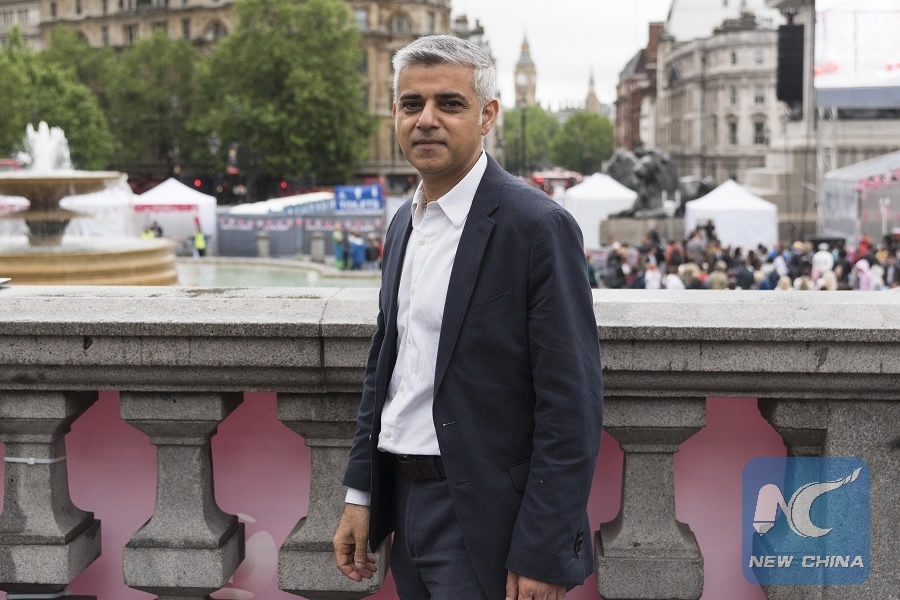
World
16:00, 17-Feb-2018
London frets over air pollution levels others would die for
By Bertram Niles

When it comes to air pollution, the levels in London are relatively low when put in a global context.
In fact, a World Health Organization report ranks the British capital 1,389th out of the nearly 3,000 cities, well behind major polluting urban centers in countries such as India, Iran, Saudi Arabia and China.
Yet, air pollution is linked to the premature deaths of more than 9,000 people a year in London, according to Sadiq Khan, the mayor of the city which has routinely failed to meet minimum European air quality standards.
As a result, he is conducting a public consultation over his plans to tackle the problem, coinciding with the 15th anniversary of the central London congestion charge, the pioneering transport levy to reduce air pollution and traffic, and which was followed up by the T-Charge, which introduced extra penalties for high-exhaust vehicles.

London Mayor Sadiq Khan is pushing hard to reduce toxic air levels in the city. /Xinhua Photo
London Mayor Sadiq Khan is pushing hard to reduce toxic air levels in the city. /Xinhua Photo
The mayor is introducing an ultra-low emission zone (ULEZ) in central London from April 2019, a year earlier than his initial proposal, replacing the T-Charge with even tighter emission standards.
It will mean higher charges for diesel cars registered before September 2015 and petrol cars registered before 2006.
Only last October, he began the process by almost doubling the fee that drivers of older, more polluting vehicles pay to drive into central London.
"We've got a health crisis in London caused by the poor quality air," he said then.

Brixton Road is regarded as London's most polluted street. /Wikipedia Photo
Brixton Road is regarded as London's most polluted street. /Wikipedia Photo
The mayor is consulting the public on extending emissions standards to the whole of London for lorries, buses and other heavy goods vehicles only in 2020 and to expand the ULEZ outside of central London for all vehicles including cars, vans, motorbikes and minibuses from 2021.
"The proposed changes ... would bring significant emissions reductions to a wider area of London," Transport for London says on its consultation hub. "There would be a 20 percent reduction in NOx (nitrogen oxide) emissions London-wide in 2020... In inner London, there would be a 30 percent reduction in NOx in 2021."
In addition to particulate matter (PM), tiny particles widely cited as the biggest cause of air pollution deaths and illness, London also has to deal with the dangerous NOx.

Air pollution in India is one of the world's highest. /VCG photo
Air pollution in India is one of the world's highest. /VCG photo
British government estimates suggest compliance for levels of the gas, much of which comes from vehicle exhaust, will not be met in the country until 2026. London is clearly on a mission to do better.
Once inhaled, PM and nitrogen oxide can affect the heart and lungs and cause serious health effects.
The law requires that the hourly measurement of toxic NOx must not exceed 200 micrograms per cubic meter (µg/m3) more than 18 times in a whole year. Brixton Road in south London, situated on eight city bus routes, has breached the limit for the whole year in the last two Januarys alone.
Data released last year revealed every area in the city exceeded World Health Organization limits for PM2.5 (inhalable particles with diameters that are generally 2.5 micrometers and smaller).
The situation is regarded by the authorities in London as urgent, notwithstanding that many other cities around the world would be jealous of its mid-table global ranking on the pollution index.
The challenge for the capital was highlighted by that Brixton reading, which meant that the capital had reached its annual air pollution limit just one month into the year for the eighth year in a row. There was small comfort in the fact it took longer to reach the limit in 2018 than last year, in keeping with the national trend of lower toxic air pollutants.

The mayor has announced plans for a cycling 'superhighway' for the good of Londoners’ health and air quality. /VCG photo
The mayor has announced plans for a cycling 'superhighway' for the good of Londoners’ health and air quality. /VCG photo
“Londoners are still breathing filthy air on a daily basis,” Simon Alcock of environmental group ClientEarth was quoted as saying when the readings were revealed. "There’s much more to do.”
In its list of the most congested cities in the world released this month, Inrix, the transportation analytics firm, put London at number seven, behind Los Angeles, Moscow, New York City, Sao Paulo, San Francisco and Bogota. The firm estimated that Londoners spent an average of 74 hours per year in gridlock last year, exposing them over time to NOx.
One campaigning group, Clean Air in London, has even gone as far as calling for a ban on alfresco dining at cafes and restaurants in some of the most at-risk areas.
Still, London's problems are not as grave as those of other cities, where the numbers of premature deaths linked to toxic air are much, much higher. At 4 a.m. GMT on Feb. 16, the air quality index reading put Delhi in India at a very unhealthy 269, Bangkok at an unhealthy 147 and Beijing (which has seen much improvement over the past year) at 155. London was at 59, which meant that the air quality was generally acceptable. But not quite clean enough.

SITEMAP
Copyright © 2018 CGTN. Beijing ICP prepared NO.16065310-3
Copyright © 2018 CGTN. Beijing ICP prepared NO.16065310-3